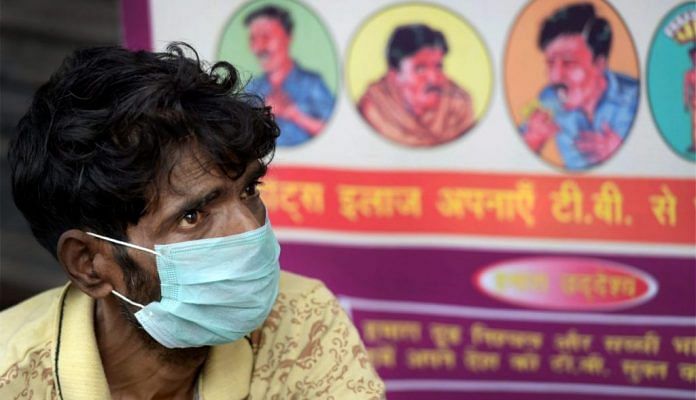Just 8 per cent of 28 lakh patients benefit from the direct benefit scheme as government also does not have bank account details.
New Delhi: The Narendra Modi government’s direct benefit scheme that aims to help eliminate tuberculosis five years ahead of a global target is struggling to make progress.
The government scheme, launched in April this year, is a nutritional supplement programme through which tuberculosis patients are to get Rs 500 a month to cater to their protein requirements in the form of eggs and pulses.
But six months into its launch, just 8 per cent of tuberculosis patients in the country are benefitting from the DBT scheme, with the government struggling to trace patients and their bank account details.
The poor numbers
India has the largest TB burden in the world — there are approximately 28 lakh patients in the country, a quarter of the world’s total cases, as per a World Health Organisation (WHO) report published in 2017.
Of these 28 lakh, the government does not have data on 15 lakh patients, and it does not have the bank account details of 10.5 lakh patients who have enrolled for the scheme.
Also read: PM Modi asked to take on the US to ensure TB drugs remain affordable
Only 2.25 lakh tuberculosis patients, barely 8 per cent of the total beneficiary pool, have started receiving the cash transfer under the scheme. The government had targeted to start the fund transfer to all patients by August.
“We are unable to trace 15 lakh patients,” said a senior official at the Ministry of Health and Family Welfare. “It includes patients who reported tuberculosis but then stopped coming for treatment, patients who were migrants or patients undergoing treatment in private hospitals.”
The official also cited disinterest for the poor reach of the scheme. “A few others are not aware of the scheme or are not too excited to share bank account details as the amount of Rs 500 is not much,” said the official.
The government had in fact registered 13 lakh TB patients on its IT platform, NIKSHAY, in 2016, but it did not collect the bank details back then.
Another official in the health ministry said its workers were fanning out across the country to trace the patients. “Our workers are at 14,000 locations across the country tracing TB patients. They are also collecting bank account details or are helping the patients open zero-balance Jan Dhan accounts,” the official said.
An ambitious target
Finance Minister Arun Jaitley had announced Rs 600 crore for the scheme during his budget presentation in February, in line with the ambitious target set by PM Modi to eliminate TB by 2025, five years ahead of the global target.
The scheme focuses on nutrition as TB is known to be a disease of malnutrition. It also hoped to address another issue red-flagged by the World Health Organisation (WHO) in 2017 – the underreporting and under-diagnosis of TB cases in India.
The government also hoped to bring all patients under a single registration system lured by the Rs 500 payment. The idea is to encourage patients to complete treatment by continuing the fund transfer as long as the treatment continues.
Also read: Top private hospitals may not participate in Modi govt’s flagship healthcare scheme
Experts, however, say that the amount is too low.
“The amount of Rs 500 needs to be raised. TB treatment, especially drug-resistant TB, can be highly sapping, considering the number of pills and side effects,” said Nandita Venkatesan, a TB survivor and activist who represented India at the United Nation’s annual General Assembly for the first high-level meeting dedicated to fighting tuberculosis.
“Also, the majority of patients visit private hospitals but government’s engagement with private sector remains weak,” she added.
Moreover, the awareness about the scheme, even among urban patients is low. “This explains the continuing low coverage of the scheme,” Venkatesan said. “There is also confusion over the mechanism of how to avail the amount. Making Aadhaar compulsory for accessing benefits can be highly exclusionary.”
The Killer TB
India continues to have the highest number of tuberculosis (TB) cases in the world even though the numbers have marginally improved.
In 2015, TB incidence was 217 per lakh population, which reduced to 211 per lakh in 2017, according to health ministry data.
“To bring that down to an incidence of 44 per lakh by 2025 is a challenge,” said a government official working on the elimination plan.




“Just 8 per cent of 28 lakh patients benefit from the direct benefit scheme as government also does not have bank account details.”
The above is a quote from the article. Some reports absolutely puzzle me. TB, by the very nature of its causes, mostly afflicts the poorer people of our society. And most of them go to government hospitals for treatment because of the expenses involved. Are we to understand that if the government genuinely wants to help these people, it cannot even ask its own hospitals to collect bank and other details first thing from the patient as soon as he steps in? Everything about this government, all their claims and schemes are all hollow talk it looks like. And they must have spent crores on the film star whom they hired for TB ad campaigns!